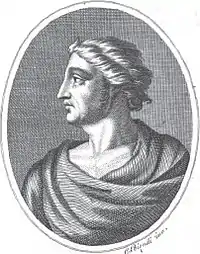Caecilius of Calacte
Caecilius of Calacte was a rhetorician and literary critic active in Rome during the reign of Augustus.[1]

The main source of information about Caecilius' life is the Suda, which says that he was from Sicily, originally called Archagathus, possibly of slave origins, and Jewish.[1] He was born about 50 BC in Calacte, and was probably a student of Apollodorus of Pergamon.[2] Both the Suda and Hermagoras say that he taught in Rome during the reign of Augustus.[3] The Suda reports that he lived until the reign of Hadrian, more than a century after the death of Augustus; this is possibly due to confusion with the quaestor Quintus Caecilius Niger.[4] A mention of Caecilius by Dionysius of Halicarnassus, who describes him as a friend in his Epistle to Pompey,[5] may have been written as early as 30 BC and suggests that he may already have been an established critic by then.[3]
He apparently wrote works of both history and literary criticism,[6] but only a few fragments of his writings are extant.[2] Athenaeus, the main source of information about Caecilius' historical works, reports that he wrote a history of the Servile Wars (slave revolts) in Sicily, and refers to a work in which Caecilius mentioned the Sicilian tyrant Agathocles.[7] He also apparently wrote about the literary merits of historians, praising Thucydides but criticising Timaeus and Theopompus.[8]
In his literary criticism, Caecilius was one of the first proponents of Atticism, alongside his friend Dionysius of Halicarnassus.[2] He wrote a treatise Against the Phrygians which apparently criticised the Asiatic style of rhetoric, producing a glossary of Attic phrases,[9] and a treatise on the difference between the Attic and Asiatic styles of rhetoric.[10] He wrote an Art of Rhetoric and a work on rhetorical figures, which is quoted by Quintilian.[9] He also wrote a treatise on the Ten Attic Orators, and individual works on the speeches of Demosthenes, Antiphon, and Lysias.[10]
Longinus' treatise On the Sublime was written in response to a work by Caecilius on the same topic.[11]
References
- Roberts 1897, p. 302.
- Weißenberger 2006.
- O'Sullivan 2005, p. 34.
- Roberts 1897, pp. 302–3.
- Roberts 1900, p. 439.
- Roberts 1897, p. 303.
- Roberts 1897, pp. 303–4.
- O'Sullivan 2005, pp. 36–37.
- Roberts 1897, p. 304.
- Roberts 1897, p. 305.
- O'Sullivan 2005, p. 36.
Works cited
- O'Sullivan, Neil (2005). "Caecilius, 'Canons', and the Origins of Atticism". In Dominik, William J. (ed.). Roman Eloquence: Rhetoric in Art and Society. London: Routledge. ISBN 0-203-43275-4.
- Roberts, W. Rhys (1897). "Caecilius of Calacte". American Journal of Philology. 18 (3): 302–312. doi:10.2307/287826. JSTOR 287826.
- Roberts, W. Rhys (1900). "The Literary Circle of Dionysius of Halicarnassus". The Classical Review. 14 (9): 439–442. doi:10.1017/S0009840X0008197X. S2CID 162999601.
- Weißenberger, Michael (2006). "Caecilius [III 5]". Brill's New Pauly. doi:10.1163/1574-9347_bnp_e222580.